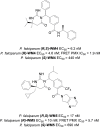The Invention of WM382, a Highly Potent PMIX/X Dual Inhibitor toward the Treatment of Malaria
- PMID: 36385924
- PMCID: PMC9661708
- DOI: 10.1021/acsmedchemlett.2c00355
The Invention of WM382, a Highly Potent PMIX/X Dual Inhibitor toward the Treatment of Malaria
Abstract
Drug resistance to first-line antimalarials-including artemisinin-is increasing, resulting in a critical need for the discovery of new agents with novel mechanisms of action. In collaboration with the Walter and Eliza Hall Institute and with funding from the Wellcome Trust, a phenotypic screen of Merck's aspartyl protease inhibitor library identified a series of plasmepsin X (PMX) hits that were more potent than chloroquine. Inspired by a PMX homology model, efforts to optimize the potency resulted in the discovery of leads that, in addition to potently inhibiting PMX, also inhibit another essential aspartic protease, plasmepsin IX (PMIX). Further potency and pharmacokinetic profile optimization efforts culminated in the discovery of WM382, a very potent dual PMIX/X inhibitor with robust in vivo efficacy at multiple stages of the malaria parasite life cycle and an excellent resistance profile.
© 2022 American Chemical Society.
Conflict of interest statement
The authors declare no competing financial interest.
Figures







References
-
- World Malaria Report 2021; World Health Organization, 2021.
-
- Imwong M.; Suwannasin K.; Kunasol C.; Sutawong K.; Mayxay M.; Rekol H.; Smithuis F. M; Hlaing T. M.; Tun K. M; van der Pluijm R. W; Tripura R.; Miotto O.; Menard D.; Dhorda M.; Day N. P J; White N. J; Dondorp A. M The spread of artemisin-resistant Plasmodium falciparum in the Greater Mekong subregion: a molecular epidemiology observational study. Lancet Infect. Dis. 2017, 17 (5), 491–497. 10.1016/S1473-3099(17)30048-8. - DOI - PMC - PubMed
-
- Favuzza P.; de Lera Ruiz M.; Thompson J. K.; Triglia T.; Ngo A.; Steel R. W. J.; Vavrek M.; Christensen J.; Healer J.; Boyce C.; Guo Z.; Hu M.; Khan T.; Murgolo N.; Zhao L.; Penington J.; Reaksudsan K.; Jarman K.; Dietrich M. H.; Richardson L.; Guo K.-Y.; Lopaticki S.; Tham W.-H.; Rottmann M.; Papenfuss T.; Robbins J. A.; Boddey J. A.; Sleebs B. E.; Sabroux H. J.; McCauley J. A.; Olsen D. B.; Cowman A. F. Dual plasmepsin-targeting antimalarial agents disrupt multiple stages of the malaria parasite life cycle. Cell Host Microbe 2020, 27 (4), 642–658. 10.1016/j.chom.2020.02.005. - DOI - PMC - PubMed
LinkOut - more resources
Full Text Sources
Chemical Information

